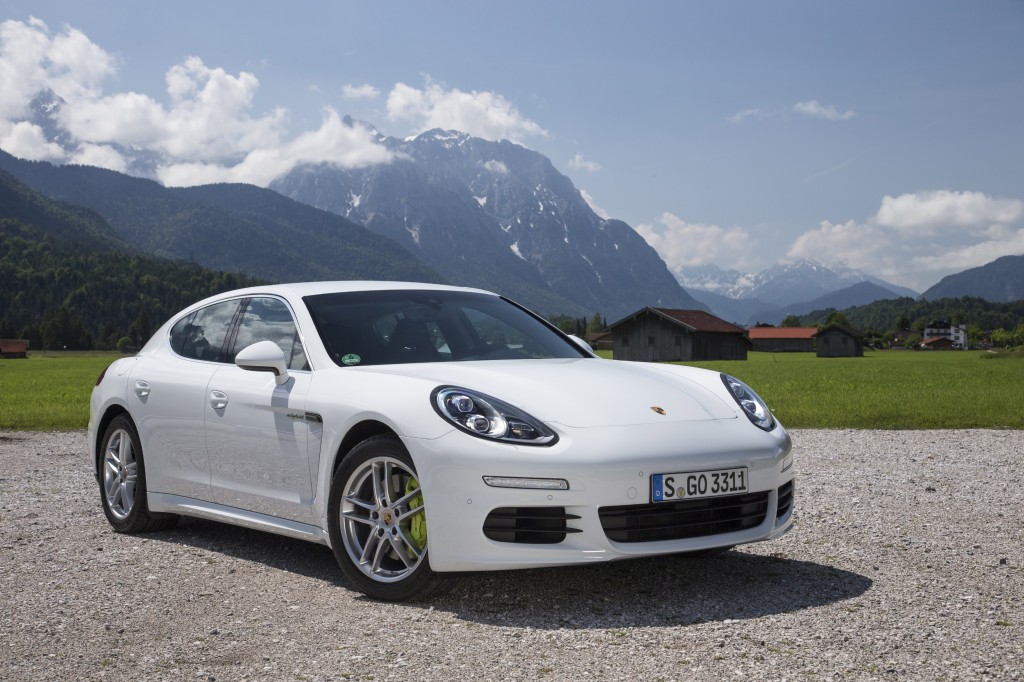First Drive: 2014 Porsche Panamera S E-Hybrid
Story by John LeBlanc
MUNICH, GERMANY – Since its debut four years ago, Porsche’s Panamera has been a one-finger salute to physics. How could a vehicle so big and so heavy go so quick and corner so adroitly? And now, as part of a mid-cycle facelift for 2014, we have the Panamera S E-Hybrid; a vehicle that defies physics in the way its saves fuel.
You may have already read my first drive of the 2014 Panamera S, where a downsized, twin-turbo gas-powered V6 replaces the outgoing model’s gas V8. That new engine and a new extended-wheelbase Executive body style are the main highlights of a refreshed 2014 Panamera lineup, but technically, the new Panamera S E-Hybrid is the more significant iteration of Porsche’s updated four-door, 2+2 hatchback, hinting at the future of luxury cars in general.
You can read here a more detailed account of the new Porsche hybrid’s technical makeup, but in brief, the new $113,300 (all base prices) rear-wheel-drive Panamera S E-Hybrid plug-in replaces the non-plug-in Panamera S Hybrid that debuted for 2012. Big changes to its gasoline-electric hybrid powertrain come in the form of a new liquid-cooled lithium-ion battery in place of the older air-cooled nickel-metal hydride unit, and an onboard charging system that allows for plug-in capability. An Audi-based, 3.0-litre gas V6 is aided by an electric motor that is nearly twice as powerful as the outgoing model. Combined, the gas-electric combo creates 416 horsepower (just 4 hp shy of the new gas $106,600 Panamera S) and 435 pound-feet of torque, channelled to the Porsche’s rear wheels via an eight-speed Tiptronic S automatic gearbox.

Before we get to the Panamera hybrid’s physics-defying performance numbers, please keep in mind that the Porsche is a full-sized luxury sedan, with business class seating for four and the ability to ferry their active lifestyle trappings in its cavernous rear cargo area. Yet this hybrid can also get from rest to 100 kilometres an hour in just 5.5 seconds (only 0.4 seconds behind the gas Panamera S). Arguably more remarkable, the S E-Hybrid scores a 3.1 L/100 km fuel economy estimate on the European driving cycle — a huge improvement over the outgoing Panamera Hybrid’s 7.1 L/100 km figure.
The big reason why the Porsche plug-in can do so is its new-found electric range, where it sips no fossil fuels at all. Where the old Panamera S Hybrid claimed just 2.0 km of electric range, the new plug-in can boast as much as 36. Of course, we’ve all been hoodwinked in the past by range claims from electrical vehicle makers, so to test the new Panamera S E-Hybrid, my driving partner and I drove a route mapped out by Porsche here in the Bavarian Alps, just south of Munich, and the results should keep Porsche EV cynics quiet.
According to the Porsche’s onboard trip computer, we drove 87.1 km over a variety of rural, city and highway roads, and averaged a speed of 62 km/h. We started out using electric power only, and surprisingly, able to beat the manufacturer’s range claim — a first for yours truly —by driving 38.5 km before we depleted the battery and the gas-V6 kicked in. And because the Panamera S E-Hybrid can be driven up to 135 km/h in electric-only mode, some of those klicks were driven at over 100 km/h on the Autobahn.

After driving another 41.6 km burning fossil fuel, the Porsche’s battery was sufficiently recharged enough for us to stop using the gas engine and drive the remaining 7.0 km of the route using electricity alone. In the end, we averaged 5.8 L/100 km.
Despite the Toyota Prius-like fuel economy, the plug-in hybrid version drives with the same refinement and panache as the 2014 gas Panamera S (rated at 8.8 L/100 km, by the way) I drove the day before. Porsche says the S E-Hybrid’s suspension was tuned to deliver higher levels of low-speed comfort. Bigger chassis mounts at the front of the car make it more rigid, the adaptive shocks and air springs have been retuned as well. The result is a supremely refined and quiet car when driven in ether electric or gas mode. The only downside is the extra weight the EV hardware adds to the S E-Hybrid’s curb weight: at 2,095 kilograms, it’s the heaviest model in the new 2014 lineup, including the top-line Panamera Turbo Executive.
From a marketing standpoint, the fact the 2014 Panamera S E-Hybrid is only available in rear-wheel-drive may hurt sales in Canada, where traditionally, the all-wheel-drive Panamera 4 models are the most popular. As well, Porsche may be missing an opportunity to offer the plug-in in the stretched Executive body style. What planet-saving rich folk wouldn’t want to be seen being chauffeured around in a zero-emissions Porsche?

Regardless, Porsche should not have any problem meeting its goal of doubling the sales of the last Panamera hybrid, which stood at around 5% of the lineup. As mainstream automakers like Nissan with its Leaf and Chevrolet with its Volt suffer through sluggish sales, luxury buyers seem to be the only ones willing to take a chance on electric cars these days. And with rivals like Audi, BMW and Mercedes-Benz also working on plug-in electric hybrid versions of their own, luxury cars like the Panamera S E-Hybrid may be more the norm than the exception in the future.






![[del.icio.us]](https://www.straight-six.com/wp-content/plugins/bookmarkify/delicious.png)
![[Digg]](https://www.straight-six.com/wp-content/plugins/bookmarkify/digg.png)
![[Facebook]](https://www.straight-six.com/wp-content/plugins/bookmarkify/facebook.png)
![[Google]](https://www.straight-six.com/wp-content/plugins/bookmarkify/google.png)
![[Reddit]](https://www.straight-six.com/wp-content/plugins/bookmarkify/reddit.png)
![[StumbleUpon]](https://www.straight-six.com/wp-content/plugins/bookmarkify/stumbleupon.png)
![[Twitter]](https://www.straight-six.com/wp-content/plugins/bookmarkify/twitter.png)
![[Email]](https://www.straight-six.com/wp-content/plugins/bookmarkify/email.png)